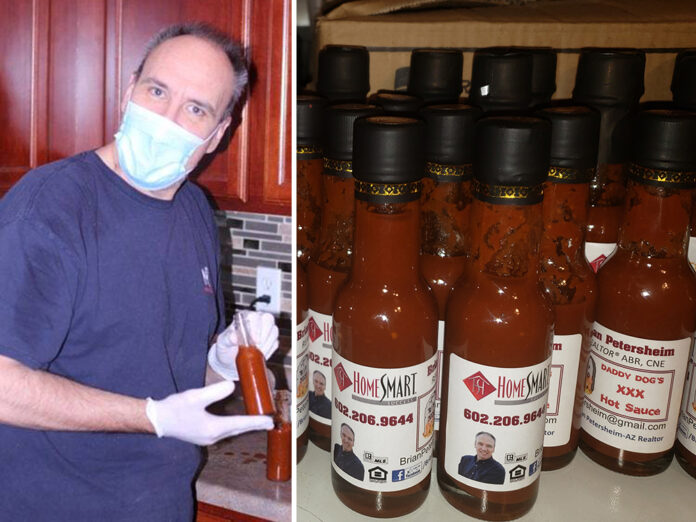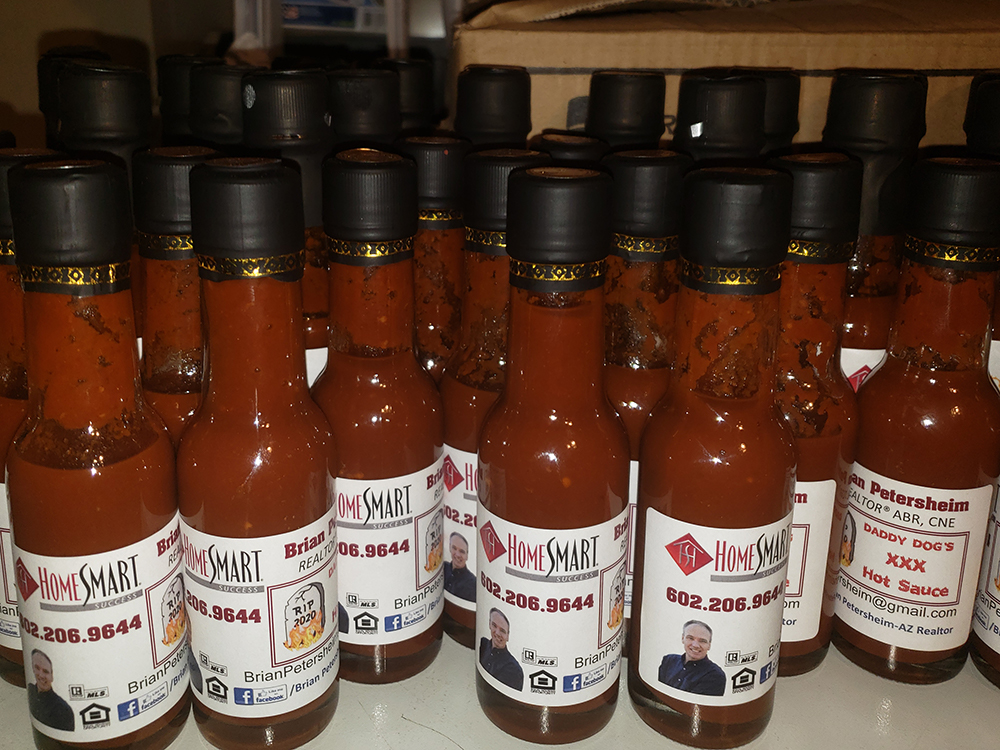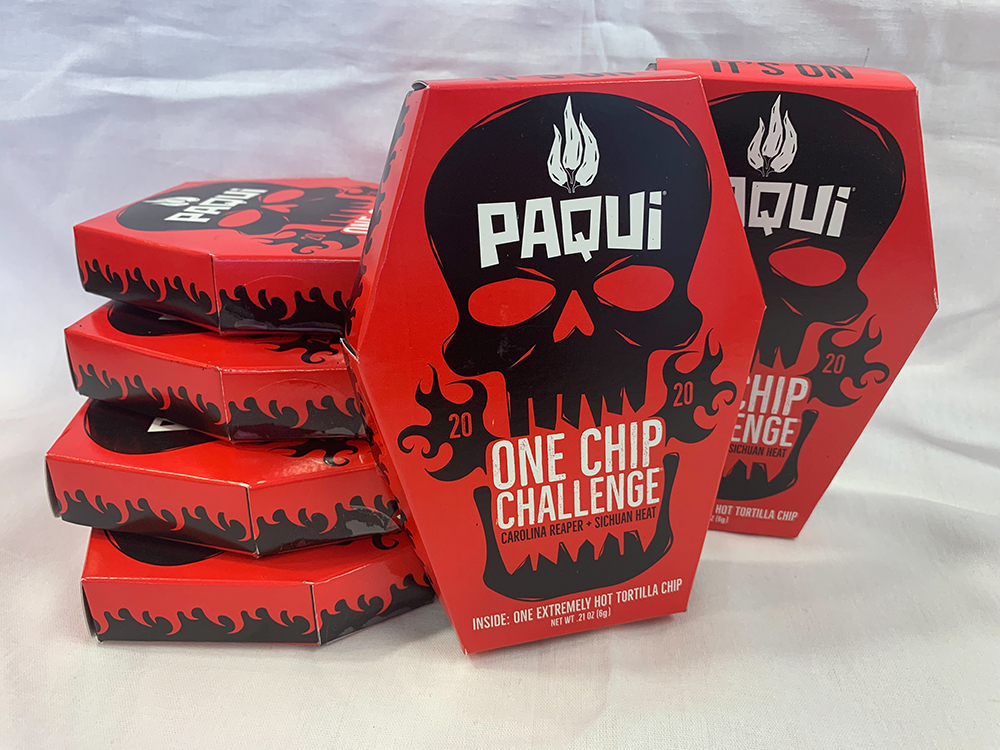By Bob McGovern -Mar 26, 2021

Brian Petersheim knows hot – and now he’s turning up the heat.
A Realtor with HomeSmart, he sells homes in the sizzling Maricopa market.
When he’s not representing home sellers (and buyers) there’s a good chance he’s in the kitchen making his own hot sauce, which he shares with interested people on his Facebook pages.
At Saturday night’s Salsa Night Market, Petersheim will amp up the heat with the “one chip challenge,” a Carolina Reaper pepper-infused tortilla chip that will test the taste buds of daring participants.
It’s kind of a logical progression for the Maricopa Meadows resident, who has gradually been pushing his way up the Scoville scale for several years.
Petersheim has always liked spicy food, rotating through a selection of hot sauces on the kitchen table. He would regularly cook dinner for his family, making two batches of the night’s meal: one spicy for him and his daughter, Haley, and another plain version for his wife, Suzanne, and son, Brian Jr.
Then, five years ago, his wife bought him a kit to “create-your-own-ghost pepper sauce” that mostly came with less-hot pepper varieties like jalapeno and habaneros, in addition to a single ghost pepper.
“That was the first time I made sauce,” he said.
SWEET, THEN ‘MOLTEN LAVA’
These days, to put the hot in his hot sauce, Petersheim’s mainstay is the Carolina Reaper, which he gets from a grower in Tennessee.
“Now I only make super hot, because I make it for just me (with his daughter at college) and that’s what I like,” he said.
The Reaper was certified as the world’s hottest chili pepper in 2017 by Guinness World Records. It was bred in 2004 by “Smokin” Ed Currie, a South Carolina grower and proprietor of the PuckerButt Pepper Co., to be one the world’s hottest peppers. It registers about an average of 1.6 million Scoville Heat Units, a measure of the pungency – or heat – of chili peppers, but can be much hotter on a single pepper basis. By comparison, jalapenos and habaneros, come in at 2,500-8,000 and 100,000-350,000, respectively, on the Scoville scale.
A crossbreed between the La Soufriere pepper from the Caribbean island of St. Vincent and a Naga Viper pepper from Pakistan, it is called “Reaper” because of the shape of its tail. Experts say the initial bite of the pepper is sweet, but then “it’s kind of like eating molten lava,” Currie has said. He has reportedly bred a hotter pepper, known as “Pepper X,” with 3.2 million Scoville Heat Units and more capsaicin, the primary active component of chili peppers. It is a chemical irritant for mammals and results in a burning sensation on contact with human tissue.
When he is ready to make more hot sauce, which Petersheim uses to market his real estate services, he will place an order and his Tennessee supplier will cram a medium-sized box full of peppers and send it off to Maricopa. During some months, after pepper season ends in March or April, Petersheim may get a half-gallon bucket of pepper mash from his supplier instead.
He adds to the Reaper peppers a mix of diced tomatoes, onions and garlic, plus a generous helping of cilantro in a mostly unsuccessful effort to make the sauce extra green.
“It doesn’t seem to work because there’s just so much pepper in it,” he said.

His surprise ingredient? Mandarin oranges. All those ingredients – plus spices, vinegar and water – go into his little food processor, with the resulting puree going into a saucepan, where it is brought to a boil and left to simmer for an hour or two, Petersheim said.
It is then brought back to boil to make sure the hot sauce is safe to put in freshly sanitized bottles. He makes about eight 6-bottle batches at a time and estimates about 1.5-2 ounce of Caroline Reaper goes into each 5-ounce bottle he makes.
Each time, the hot sauce gets a fresh name and label under his Daddy Dog moniker. His most recent batch, made about two weeks ago, was named “Rest in Peace 2020.”
He gives away at least 15-20 bottles from each batch to people through a simple contest on his Facebook pages, using the distribution as a “passionate” marketing tool to connect with potential real estate clients. He includes his business card on the bottle and typically requires winners pick up their sauce from his home so he can make a personal introduction.
The Paqui “one chip challenge” comes in a coffin-shaped box replete with multiple warnings, like “Inside: One extremely hot tortilla chip” and “Warning: It hurts like hell,” plus an advisory that chip-eaters seek medical attention if they experience difficulty breathing, fainting or extended nausea.
“I enjoy it,” he said. “It puts me face-to-face with people who like hot sauce and who may want to buy or sell a house down the road.”
His sauce has already directly led to one home sale and two listings, he said.
PACKING THE HEAT
Petersheim said his wife keeps telling him to make hot sauce as a side hustle, but he has resisted.
“I mean, the truth is that it is so hot, I’m just afraid that if I charge people for it, then they will complain about it” when they can’t eat it, he said.
On Saturday night, he will be sharing the heat – but not his sauce – with the community at Salsa Night Market at Copper Sky.
Last summer, Petersheim ordered a several of boxes of the Paqui “one chip challenge” tortilla chips intending to host a public event to give people an opportunity to dare to eat the chip. An event proposed in partnership with InMaricopa was tentatively planned for the fall, but then postponed due to a rising number of COVID-19 cases.
For the uninitiated, the one chip challenge consists of a single, wrapped blue corn tortilla chip infused with Carolina Reaper pepper, chipotle pepper powder, Sichuan pepper and Sichuan pepper extract.

It comes in a coffin-shaped box replete with multiple warnings, like “Inside: One extremely hot tortilla chip” and “Warning: It hurts like hell,” plus an advisory that chip-eaters seek medical attention if they experience difficulty breathing, fainting or extended nausea.
For all the pain it apparently inflicts, there are plenty of folks who believe they are up to the challenged.
On Wednesday, the city’s director of community services, Nathan Ullyot, and InMaricopa multimedia expert Kyle Norby ate the chip on Facebook Live. There was sweat on the forehead and reddened eyes, followed by a general nasty feeling in the stomach that eventually passed.
They apparently fared better than Petersheim, who ate the chip about a month ago and suffered stomach symptoms he did not see coming.
“What I mean by not expecting it, is you know you think, ‘Oh my mouth is going to burn for a few minutes and it’s going to stop’ but what you don’t expect, and not everybody gets it but I learned that I do, is stomach cramps,” he said.
“So, what happens is that the capsaicin, which is the pepper, gets down into your gut and it like leans against the side of your belly. The chip, if it’s if it’s leaning there, you’ve got to kind of lay down. That’s what I did. I lay down and then as I felt the chip move, I had to flip sides because it just didn’t care and just cramped.”
His one-chip challenge burned his mouth for about 15 minutes after drinking milk to mitigate the capsaicin fire. The stomach cramps kicked in after the mouth-burn subsided, and lasted for over an hour, he said.
Petersheim and InMaricopa will offer the free challenge to a limited number of participants at the Salsa Festival and Night Market, which runs from 5 to 9 p.m. Saturday. Those interested in taking the challenge must sign up at our booth. There will be multiple rounds so people are encouraged to sign up early. Milk, crackers and bread will be on hand, as well as gloves to prevent contamination to the eyes. A waiver will be required of participants.
